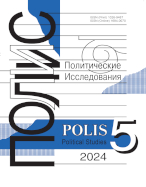The Future of Nuclear Deterrence:
Discussions and Realities
DOI: 10.17976/jpps/2004.05.15
Fenenko A.V. The Future of Nuclear Deterrence: Discussions and Realities . – Polis. Political Studies. 2004. No. 5. https://doi.org/10.17976/jpps/2004.05.15
An attempt is made in the article to answer the question whether nuclear deterrence conceived as a system of views and as real-political practice, will prove able to adapt itself to the conditions of the swiftly changing world. The author retraces the evolution of this concept at the stretch of the second half of the 20th century, points to the differences in its interpretations by home and Western analysts. He relates the phenomenon of destruction of nuclear deterrence to the creation of high precision weapon and of weapon as powerful as the nuclear one, but not bringing a global ecological disaster - which resulted in the appearance of scenarios of a realistic nuclear war. In the author's opinion, an entirely new conception of deterrence is rapidly forming under modern conditions. Its main mission is now seen in keeping in check negative world political processes (international terrorism, Islamic extremism e.a.), and as for pursuing a policy of preventing global war, it implies to an ever greater extent recourse to limited force actions, including ones with nuclear weapon or its analogues used.
See also:
Palmowski T., Fedorov G.M.,
Russian-Polish Borderland: Problems and Prospects for the Development of Cross-Border Relations. – Polis. Political Studies. 2020. No2
Zamyatin D.N.,
Geopolitics: Major Problems and Results of Development in the 20th Century. – Polis. Political Studies. 2001. No6
Kiselyov I.Yu.,
The Images of States in International Relations: Mechanisms of Transformation. – Polis. Political Studies. 2003. No3
Sakwa R.,
Back to the Wall: Myths and Mistakes that Made the Ukraine Crisis. – Polis. Political Studies. 2015. No4
Korotayev A.V., Bilyuga S.E., Shishkina A.R.,
Correlation between GDP per Capita and Protest Intensity: a Quantitative Analysis. – Polis. Political Studies. 2017. No2





.jpg)






 print
print
.jpg)
.jpg)